It’s summer, so naturally, it is hot and humid outside across the Ohio Valley, but some days it’s unbearable.
Well, blame it on the corn.
This week is the prime example how higher humidity can go a long way, especially with a streak of heat.
As the Buckeye State bakes under the heat dome, temperatures not only pushed over 90 degrees, but it felt even hotter with heat index values of 100 degrees or higher.
The heat index is also known as the apparent temperature and is what the temperature feels like to the human body when relative humidity is combined with the air temperature, according the National Oceanic and Atmospheric Administration.
When it feels like 100+, it is because of the humidity, which is measured by the dew point. Typically, Ohio has dew points in the 60s, which means it feels muggy, but when dew points jump into the 70s, that is when conditions can feel oppressive and very uncomfortable.
On days with high humidity, you may walk outside and think you are in Florida! That may seem corny, but it is true. That tropical, humid air mass can also occur across the Midwest and the northern Plains with the help of corn.
Yes, corn can help contribute to the high humidity through the Corn Belt, including in Ohio.
During the summer, we experience our highest temperatures of the year whenever there is a heat dome, which is a large area of high pressure that parks itself near the east coast of the United States.
The airflow circulating around this high pressure moves clockwise, so it can bring very warm air from the south and moisture from the Gulf of Mexico far northward. Sometimes the moisture can also come from the Atlantic Ocean.
The tropical air mass and corn influence can create some uncomfortable days in Ohio. As the corn matures in the fields, it can "sweat" and raise the humidity level.
The National Weather Service describes corn transpiration, also known as corn sweat, as moisture given off by the plants through their leaves as they move through the growing season. Transpiration is water evaporating from the plant leaves.

The winds blowing through the fields help transport this moisture from the corn leaves, allowing the corn to continue the transpiration process.
Thus, the added moisture released can lead to higher humidity levels and can increase the heat index in a localized area. This process can add 5 to 10 degrees to the dew point.
According the National Weather Service in Wilmington, Ohio, mature Ohio corn releases approximately 10 billion gallons of water into the air per day.
So the next time you sweat on a hot summer day, just know the corn is also sweating. On the bright side, this trend ends around mid-to-late August.
Our team of meteorologists dives deep into the science of weather and breaks down timely weather data and information. To view more weather and climate stories, check out our weather blogs section.



